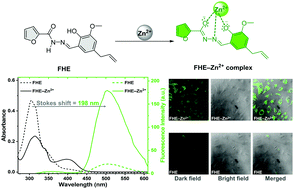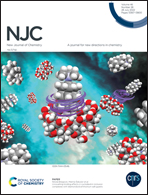Fluorescence ‘turn-on’ probe for nanomolar Zn(ii) detection in living cells and environmental samples†
Abstract
Herein, a Schiff base ligand FHE was synthesized by condensing 5-allyl-2-hydroxy-3-methoxybenzaldehyde, a eugenol derivative, with the derivative furan-2-carbohydrazide. FHE alone showed low fluorescence signals due to intramolecular charge transfer (ICT). FHE showed highly specific FHE–Zn2+ complex formation (Ka = 1.1 × 104 M−1) upon titration with Zn2+ ions in HEPES buffer (pH = 7.4, 50% ACN, v/v), which resulted in the disruption of ICT followed by a chelation enhanced fluorescence (CHEF) effect. The complexation of FHE with Zn2+ demonstrated a large Stokes shift (Δλ = 198 nm, λex = 305 nm, λem = 503 nm) with a 20-fold increase in the quantum yield (FHE, Φ = 0.016; FHE–Zn2+ complex, Φ = 0.34). Notably, with the LOD of 12.7 nM for detecting Zn2+ ions with green fluorescence and no interference from potentially competing cations and anions, FHE showed high biocompatibility. FHE was successfully used for the nanomolar detection of intracellular Zn2+ ions, indicating its live-cell-imaging applicability. Furthermore, FHE also showed promising results in the detection of Zn2+ in environmental samples. These results validate the potential applicability of FHE for detecting Zn2+ in living cells and in environmental samples such as river water and tap water.



 Please wait while we load your content...
Please wait while we load your content...